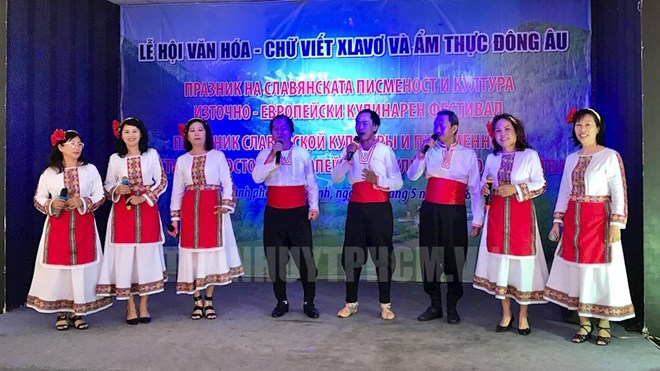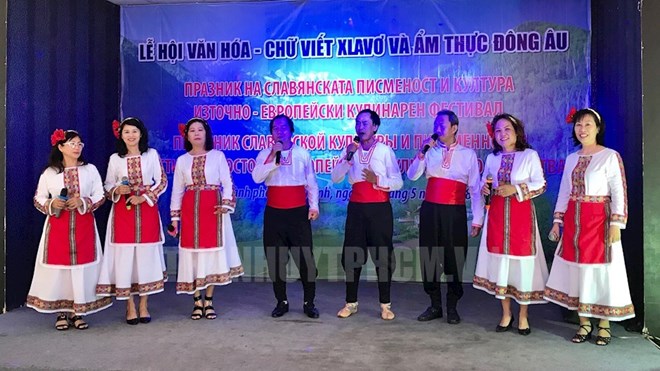
Events to mark the Day of Slavic Writing and Culture (May 24) were held in Ho Chi Minh City and Hanoi on May 26.

An
art performance at the event in Ho Chi Minh City. (Source: VNA)
In HCM City, the event was hosted by the Ho Chi Minh City Union of
Friendship Organisations the Vietnam-Bulgaria Friendship Association and the
Vietnam-Russia Friendship Association in the city.
Speaking at the festival, Hoang Thai Lan, Chairwoman of the Vietnam-Bulgaria
Friendship Association in HCM City, said the Day of Slavic Writing and Culture
(May 24) is observed annually by Slavic countries to commemorate Saints Cyril
and Methodius, who created the Slavic writing.
Currently, more than 250 million people across the world are using the writing
system, contributing to the development of the European civilization. The
Slavic countries include Russia, Bulgaria, the Czech Republic, Poland, Ukraine,
Belarus, Serbia and Croatia, among others.
Chargé d' Affairs of the Bulgarian Embassy in Vietnam Marinela
Petkova highlighted cooperation in politics, economy, education, tourism,
culture and sports between Vietnam and Bulgaria.
The two countries boast substantial potential for economic collaboration, she
said, noting that Bulgaria highly values economic achievements Vietnam has
recorded in recent years.
The diplomat held that more efforts should be made to deepen the bilateral
ties.-
Source: VNA
With an increasingly vibrant and widespread emulation movement aimed at building cultured residential areas and cultured families, Yen Thuy District has been making steady progress toward improving both the material and spiritual well-being of its people, while fostering a civilized, prosperous, beautiful, and progressive community.
Once lacking recreational spaces and community facilities, Residential Group 2 in Quynh Lam Ward (Hoa Binh City) has recently received attention for the construction of a new, spacious, and fully equipped cultural house. The project followed the model of state support combined with public contributions in both labor and funding.
The "All people unite to build cultural life" movement, which has been effectively integrated with Kim Boi district’s socio-economic development goals, is fostering a lively spirit of emulation across local residential areas, hamlets, villages, public agencies, and enterprises. In addition, through the initiative, traditional cultural values are being preserved and promoted, while community solidarity and mutual support in poverty reduction and economic development are being strengthened.
A working delegation of the Hoa Binh provincial People’s Committee led by its Permanent Vice Chairman Nguyen Van Toan on June 11 inspected the progress of a project to build the Mo Muong Cultural Heritage Conservation Space linked to tourism services in Hop Phong commune, Cao Phong district.
Born and growing in the heroic land of Muong Dong, Dinh Thi Kieu Dung, a resident in Bo town of Kim Boi district, in her childhood was nurtured by the sweet lullabies of her grandmother and mother. These melodies deeply imprinted on her soul, becoming an inseparable part of her love for her ethnic group's culture. For over 20 years, this love for her hometown has driven Dung to research, collect, and pass down the cultural values of the Muong people to future generations.
In the final days of May, the Ethnic Art Troupe of Hoa Binh Province organized performances to serve the people in remote, mountainous, and particularly disadvantaged areas within the province. These were not just ordinary artistic shows, but they were the meaningful journeys aimed at spreading cultural values, enhancing the spiritual life of the people and contributing to the preservation of ethnic minority cultural identities.



